| ARTIGO ARTICLE |
|
Elisabeth Meloni Vieira1 | Do women's attitudes towards abortion and contraceptive methods influence their option for sterilization? As atitudes das mulheres em relação ao aborto e ao uso de métodos anticoncepcionais influenciam na sua opção pela esterilização?
|
| 1 Departamento de Medicina Social, Faculdade de Medicina de Ribeirão Preto, Hospital das Clínicas. Av. dos Bandeirantes 3900, Ribeirão Preto, SP 14049-900, Brazil. | Abstract This paper analyzes the attitudes of low-income women towards abortion and contraception. A survey was conducted in 1992 with a total of 3,149 childbearing-age women living on the outskirts of the Greater Metropolitan São Paulo Area. The study focuses on a sub-sample of 583 women. Attitudes of sterilized and non-sterilized women are compared. Women, especially those sterilized, found the most important attribute of a contraceptive method to be its effectiveness. Women currently taking the pill were less likely than those sterilized to agree that sterilization was the best method because of its effectiveness. Sterilized women were less likely than non-sterilized women to trust the pill. Sterilized women were more likely than non-sterilized to have reported adverse effects from the pill. Most women found abortion unacceptable except in the case of risk to the woman's life. Women using more effective methods showed stronger negative attitudes towards abortion. The tendency to be sterilized while still young was associated with more negative attitudes towards abortion. Family planning activities in basic health care services should include individual counseling for contraceptive use. Key words Family planning; Contraception; Attitudes; Abortion Resumo Este artigo analisa as atitudes em relação ao aborto e uso de métodos anticoncepcionais entre mulheres de baixa renda moradoras da periferia da região metropolitana de São Paulo. Uma subamostra de 583 mulheres participantes uma pesquisa realizada em 1992 é examinada, mostrando que o mais importante atributo de um método contraceptivo é a sua efetividade, especialmente para as esterilizadas. As mulheres que tomavam pílula tinham menor chance de concordar que o melhor método era a esterilização, por causa de sua efetividade. Mulheres esterilizadas, comparadas às usuárias da pílula, tinham menos chance de confiar na pílula e relataram efeitos adversos causados pelo uso do anticoncepcional. Muitas acham o aborto inaceitável, exceto nos casos em que há risco de vida para a mulher. Mulheres que usam métodos mais efetivos mostraram ter atitudes mais fortes contra o aborto. A tendência para submeter-se à esterilização mais jovem foi encontrada associada com atitudes mais negativas em relação ao aborto. As atividades de planejamento familiar no sistema de atenção primária à saúde deveriam incluir o aconselhamento individual para o uso de contraceptivos.
|
Introduction
According to the most recent Brazilian Demographic and Health Survey (DHS), conducted in 1996, 76.7% of childbearing-age married women were using some form of contraception, amongst whom 40% were sterilized (BEMFAM/Macro, 1997). The issue of sterilization has been well studied over the last few decades from a number of demographic, public-health, social, and anthropological perspectives (Minella, 1998). Interest in the subject arose after the rapid decline in fertility in Brazil starting in the 1970s, especially since the country had never adopted an official birth control policy. Family planning was supposed to have been provided officially by the public health care system since 1983. However, legal regulation of family planning did not occur until 1997, despite the new Federal Constitution of 1988 stating that it was a basic citizen's right.
Only two contraceptive methods are prevalent in the country: female sterilization (40%) and the pill (20.7%), indicating that family planning services are grossly inadequate. Several studies of the public health system have shown that the main problems in family planning provision are the lack of contraceptives, lack of properly trained health professionals, and insufficient family planning information (Villela et al., 1988; Costa, 1992; WHO, 1994).
It has been suggested that female sterilization is a response to the lack of alternative methods and the dangers of illegal abortion. In fact, according to some authors, female sterilization has occupied a void left by the lack of other contraceptive options and proper information on human reproduction and contraception (Barroso, 1988; Berquó, 1989). The problem with family planning in Brazil relates not only to the predominance of sterilization and the pill, i.e., the very provision of methods itself is inappropriate. Oral contraceptives have been marketed at low prices and have been available in pharmacies since the 1960s. Pills are sold with no prescription, counseling, or medical supervision (Costa et al., 1990). Other authors have emphasized that choices of contraceptives are inadequate. According to a study in São Paulo, 40% of women on the pill presented risk factors (Hardy et al., 1991) and a Demographic Health Survey showed that 90.5% of them buy the product directly over the counter (BEMFAM/Macro, 1997).
The absence of formal regulation led to a situation in which sterilization has been widely but clandestinely practiced (Vieira, 1994; Vieira & Ford, 1995). The lack of records impedes effective control of the procedure by the public health system (Barros et al., 1991), while the fact that tubal ligations are performed in combination with unnecessary cesarean sections increases the risk of maternal morbidity and mortality (Faúndes & Cecatti, 1993). According to a study in São Paulo, one-third of maternal deaths were associated with unnecessary cesarean sections (Volochko, 1992).
New family planning legislation (Federal Act 9,263) was approved in August 1997, and the Ministry of Health published guidelines on procedures in November 1997 (MS, 1997), which were subsequently recognized as covered by the Unified Health System (SUS). Some authors have argued that a "culture of sterilization" ensued (Berquó, 1993) and that women "naturally" expect to end their reproductive cycle with tubal ligation (Citelli, 1998). A study on regret after sterilization found that the independent variable "history of problems with reversible contraceptives" was among the factors leading women to undergo sterilization at an early age (Vieira, 1994; Vieira & Ford, 1996; Vieira, 1997). This paper analyzes attitudes towards contraception, including abortion, as factors influencing women to submit to sterilization. Prior experience with contraceptives is taken into account as an important background variable for women's choice.
Material and methods
A survey among low-income women residing in two municipalities from the Greater Metropolitan São Paulo Area was conducted in 1992. The sample was obtained through a two-step sampling cluster system in which 45 streets were randomly selected. Interviewers visited each street up to three times during the week and on weekends. A total of 3,803 households were recorded, and 4,976 childbearing-age women (15-49 years) were identified as living in the households. Despite all attempts to locate them, 34% of identified women were unavailable for interviews and 3% refused to be interviewed; hence a total of 3,149 women (63%) were interviewed. The survey was conducted in two steps. The first step (which is the object of this paper) consisted of 12 questions on contraceptive use. More detailed information on the study's methodology has been published elsewhere (Vieira, 1994; Vieira & Ford, 1995; Vieira, 1997). An additional set of 15 questions were given to a sub-sample of 583 women to investigate women's attitudes towards contraception and abortion. The set of questions on attitudes towards abortion was constructed and analyzed as a Likert scale and scored in order to be represented as a single variable.
Data were processed and analyzed using the SPSS-PC+ program. The analysis includes frequency distribution of the main variables and testing of hypotheses at the bivariate level using the chi-square test. The null hypothesis was accepted if p < 0.05.
Results
In the sample of 3,149 women, many had started marital relationships at a fairly young age. Approximately 20% of women from 15 to 19 years of age and 60% of those from 20 to 24 were already married. Sixty percent of all women from 15 to 49 years of age used contraceptive methods. The most frequently used method was the pill (26%), and the second most common was female sterilization (22%). All other methods combined totaled 12% of respondents, while 40% were not using any form of contraception.
Marital union is strongly associated with contraceptive use, i.e., 80% of women in marital relationships were using a family planning method as compared to only 15% of single women. Among married women the most frequently used method was the pill (34.4%) and the second was female sterilization (29.2%). Women under 30 preferred the pill, while sterilization was the most frequently used method among women 30 or older. Some 51% of sterilized women were under 30.
The sub-sample consisted of 583 women. Most (74.4%) were between the ages of 20 and 39, with 217 (37.4%) from 20 to 29 and 215 (37%) from 30 to 39; only 5.7% (33) were 15 to 19 years old and 19.9% (116) aged 40-49. Most of the women, 535 (92%), were married or living in a consensual union and only 48 (8%) were not living with a male partner. Nearly all of the women (99%) were using some form of contraception. Of these, 40.8% (236) were on the pill, 40% (231) were sterilized, and the remaining 19.1% (111) were using other methods (coitus interruptus 5.5%, condoms 4.2%, vasectomy 3.6%, rhythm 1.9%, injectables 1.9%, IUDs 1.0%, and other methods 1.0%).
Contraceptive methods
Seven statements regarding contraceptive methods were read to the respondents for them to agree or disagree. The results are shown in Table 1.
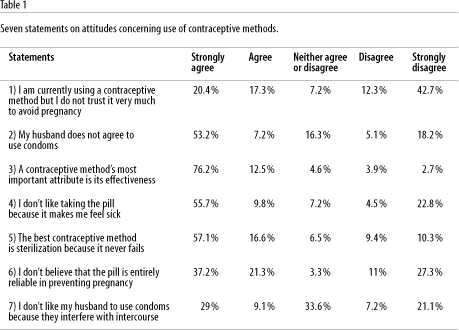
The strongest agreement (76.2%) was with the statement that a contraceptive method's most important attribute is its effectiveness. This was followed by the statement that sterilization is the best method because it never fails (to which 73.7% agreed).
Many women reported side effects from the pill, and 65.5% of the respondents agreed with this statement. Some 60.4% said that their husbands did not agree to use condoms, and 58.5% did believe that the pill was totally reliable. Although 37.7% said they did not trust the method they were currently using, this statement also showed the highest level of disagreement (42.7%). The statement with which the most women neither agreed nor disagreed (33.6%) was, "I prefer that my husband not use condoms because they interfere with intercourse." This suggests that many women did not know how to respond to the statement, probably because they had never used condoms with their partners during intercourse. This result is consistent with the low frequency of condom use in the sample, i.e., only about 4%.
Women using the pill and other methods reported trusting these methods less than sterilized women did sterilization. About 27.7% of sterilized women agreed with statement number 1: "I am currently using a contraceptive method, but I do not trust it very much to prevent pregnancy", whereas 40.7% of women using the pill and 51.7% of women using other contraceptives agreed with it. The difference was statistically significant (Table 2).
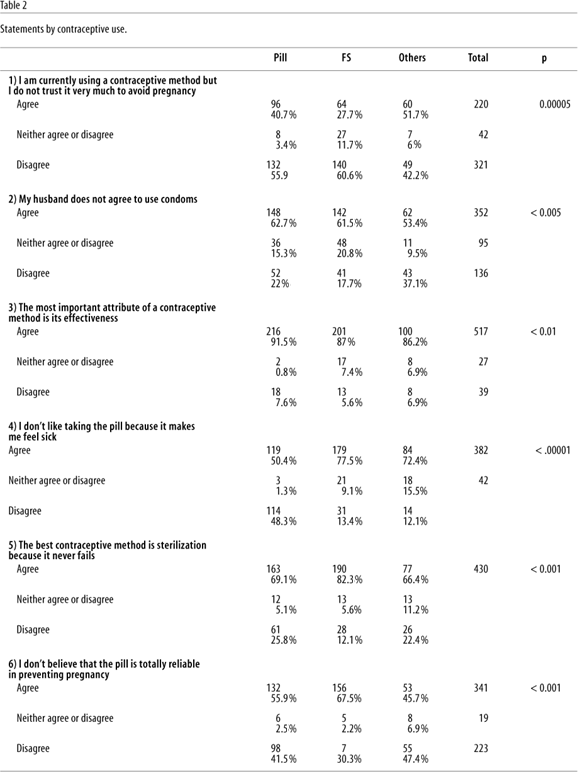
There was a positive association between agreement with statement number 1 and early age (p<0.005). Among women under 30, 45.6% agreed with this statement, whereas only 32% of women 30 or over agreed with it (data not shown).
The relationship between the two variables (trust in the current contraceptive method and contraceptive used) was controlled by the age variable, since there is a known association between age and contraceptive use among this population. This association was present only for women 30 or older (p<0.0006). Only 26.5% of sterilized women 30 or older agreed with statement number 1, whereas 40.5% of women using the pill or other methods agreed with the statement. This means that women 30 or older on the pill or other methods were less likely to trust their current method as compared to sterilized women. It also indicates that the pill's perceived unreliability is not as important for women under 30.
Women using methods other than sterilization or the pill were more likely to disagree with statement number 2: "My husband does not agree to condom use." About 37% of women using other contraceptive methods disagreed, while 22% of women on the pill and 17.7% of sterilized women disagreed with this statement (Table 2).
Women using the pill (91.5%) were more likely to require effectiveness from their current method and less likely to be unsure about statement number 3: "A contraceptive method's most important attribute is its effectiveness." The difference between women on the pill and the other two groups, sterilized women (87%) and those using other methods (86%), was statistically significant (Table 2).
Sterilized women were more likely to agree with statement number 4: "I don't like taking the pill because it makes me sick", than women who were actually taking the pill or using other methods. Half (50.4%) of the women taking the pill agreed with this statement, while three quarters of the sterilized women (77.5%) and those using other methods (72.4%) agreed with the statement (Table 2). There was a significant association between the answer to this statement and the respondent's age. Women 30 or older were more likely to agree with statement number 4 (Table 3). This can be explained by the association between use of the pill among women under 30 and sterilization in women 30 or older. The association remained for both age groups after controlling for age, suggesting that side effects from the pill were an important factor for sterilization (Table 3).
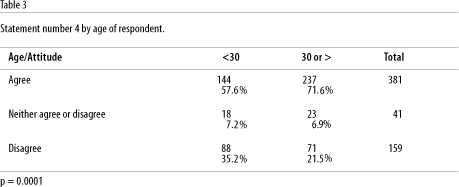
Women using the pill or other methods were less likely to agree with statement number 5: "Sterilization is the best contraceptive method because it never fails" (25.8% and 22.4%, respectively, compared to 12.1%) (Table 2).
Sterilized women were less likely to trust the pill than women who were actually on the pill or using another method. Table 2 shows the relationship between statement number 6, "I don't believe that the pill is totally reliable in preventing pregnancy", and the contraceptive method actually used. About 67% of sterilized women agreed with this statement, as compared to 56% of women on the pill.
Abortion
Eight statements related to abortion were read to the same respondents, and the results are shown in Table 4. A full 82.8% of the respondents strongly agreed that abortion is a serious sin, and 72% responded that they would not terminate a pregnancy even if having a child would mean a disaster in their lives. About 69% of women strongly disagreed that abortion should be accessible to every woman who decides to discontinue her pregnancy. Most women, 66.8%, strongly disagreed with abortion, even if pregnancy was the result of contraceptive failure. About 74% were aware that intentionally taking medication to terminate a pregnancy is tantamount to performing an abortion. The only circumstance in which abortion was acceptable to most women (69.1%) was in the case of risk to the woman's life if the pregnancy were allowed to continue.
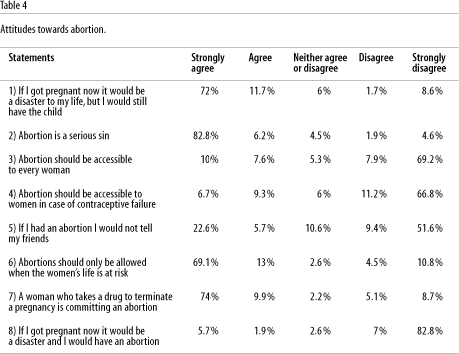
The above set of statements was merged into a single variable measuring attitudes towards abortion, with a maximum score of 40, a minimum of 8, and a mean of 17.7. Most respondents (59.4%) were against abortion, with 27.8% heavily against it and 31.6% less adamant. About 40.7% had less restrictive attitudes towards abortion. This ordinal variable was measured against type of contraceptive used, age of respondent, age at sterilization, and marital status. Women using more effective methods (the pill, 48.4%, and sterilization, 37.5%) showed stronger attitudes against abortion than women using other methods (14.3%) (Table 5).
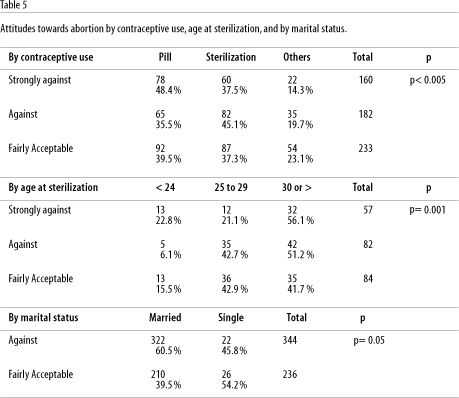
Statistically significant differences were found between the groups with different attitudes towards abortion and age at sterilization (Table 5). Among the women who were heavily against abortion, 22% had been sterilized at 24 or earlier. Meanwhile, among those who were less negative towards abortion, only 15.5% had been sterilized under the age of 24. Hence, the tendency to undergo sterilization earlier in life is associated with a more negative attitude towards abortion. Married and cohabiting women were more likely to be against abortion (60.5%) than those not cohabiting (45.8%), and this difference was statistically significant (Table 5).
Discussion
The analysis of attitudes towards contraception showed that women using contraceptive methods strongly emphasized the need for high rates of effectiveness for their respective methods. This probably explains why most women considered sterilization the best method. More than half (55%) trusted the contraceptive they were using, while most women (65.5%) reported side effects from taking the pill. Most sterilized women trusted sterilization more than women who were using the pill and other methods. This trend was greater among older women (over 30 years), while women on the pill trusted the method less than their peers who were sterilized. This is probably related to contraceptive failure. Women on the pill demanded more effectiveness from the method. Few sterilized women were undecided as to whether effectiveness was a contraceptive method's most important characteristic.
Proportionally more sterilized women reported side effects from the pill than did women actually using oral contraceptives. This may have been an important factor in their submitting to sterilization. In addition, more women on the pill disagreed with the statement that surgical sterilization was the best contraceptive method, while sterilized women were less likely to trust in the pill. This analysis shows a strong consistency between attitudes and behavior among these women.
The analysis of attitudes showed that abortion is generally not accepted, being considered a serious sin. The only situation in which it was considered relatively acceptable was when there was a risk to the woman's life if the pregnancy were allowed to continue. Attitudes against abortion are positively associated with the use of more effective methods and younger age at sterilization. Unmarried or non-cohabiting women were less negative towards abortion. This may relate to society's views towards single parenthood.
Negative attitudes towards oral contraceptives are probably the result of women's previous negative experiences. Indeed, problems with the provision of family planning in Brazil are multi-faceted. The survey drew attention to several problems associated with the prevalence of only two contraceptive methods. The fact that oral contraceptives are easily accessible (and affordable at pharmacies) is a problem, since available pills are the ones most likely to cause side effects due to the high estrogen dosage (WHO, 1994). These same pills could be a cause of high dropout rates due to side effects, meanwhile creating a negative experience for women, in addition to increased health risks. According to the DHS (BEMFAM/Macro, 1997), among women on the pill who stopped using it, 14.1% cited contraceptive failure as compared to 36.3% who reported adverse effects (Wong et al., 1998). In Brazil's extremely medicalized family planning program, public health services act as barriers against women receiving proper care. Such barriers include long waiting times for appointments, difficult access, absence of individual counseling, and lack of accurate and up-to-date family planning information among health professionals (WHO, 1994).
Conclusion
Effectiveness and side effects are the two most important attributes influencing women's choice of a contraceptive method. Women's attitudes toward contraceptive methods and abortion indicate that the option for sterilization is related to prior use of contraceptive methods, particularly contraceptive failure and adverse effects. Further investigation on prior contraceptive methods and the option for sterilization will shed more light on the issue. In addition, the regulation of family planning should make contraceptive choice readily available in the public health system with proper quality of care. Women's prior experience with contraceptive methods should be taken into account by health professionals providing counseling in family planning. Family planning activities should be more effectively incorporated into basic health care services.
Acknowledgment
The data presented in this paper are taken partly from the author's doctoral thesis entitled Regret After Female sterilization among low income women in São Paulo Brazil, which was approved by the Institute of Population Studies, University of Exeter, UK, in 1994. It is registered in the British Thesis Service of the British Library under number DX 182665, UK.
The author gratefully acknowledges the support of the World Health Organization's Task Force for Social Science Research on Reproductive Health for funding this study, as well as the World Bank's Graduate Scholarship Program and the Conselho Nacional de Desenvolvimento Científico e Tecnológico (CNPq) (Brazilian National Research Council) for their academic support. The author also thanks Dr. Nicholas John Ford for his thorough supervision of her Ph.D. thesis and Ms. Elspeth Mathie for the English-language revision of the article.
References
BARROS, F. C.; VAUGHAN, J. P.; VICTORA, C. G. & HUTTLY, S. R. A., 1991. Epidemic of caesarean sections in Brazil. Lancet, 338:167-169.
BARROSO, C., 1988. A Esterilização no Brazil. Comissão de Estudos de Direitos da Reprodução. Brasília: Ministério da Saúde.
BEMFAM (Sociedade Civil Bem-Estar Familiar no Brasil/Macro, 1997. Pesquisa Nacional sobre Demografia e Saúde. Brasil 1996. Rio de Janeiro: BEMFAM.
BERQUÓ, E., 1989. A esterilização femininina hoje. Ciência e Tecnologia, 88:598-610.
BERQUÓ, E., 1993. Brasil, um caso exemplar (anticoncepção e partos cirúrgicos) à espera de uma ação exemplar. Seminário: A Situação da Mulher e o Desenvolvimento, Campinas: Núcleo de Estudos de População, Universidade Estadual de Campinas.
COSTA, S. H.; MARTIN, I. R., FREITAS, S. R. S. & PINTO, C. S., 1990. Family Planning among low income women in Rio de Janeiro: 1984-1985. International Family Planning Perspectives, 16:16-22.
COSTA, A. M., 1992. O PAISM: Uma Política de Assistência Integral à Saúde da Mulher a ser Resgatada. Comissão de Cidadania e Reprodução. São Paulo: Centro Brasileiro de Planejamento - CEBRAP.
CITELLI, M. T.; SOUZA, C. M. & PORTELA, A., 1995. Reveses da Anticoncepção entre mulheres pobres. In: Doença, Sofrimento e Perturbação: Perspectivas Etnográficas (L. F. Duarte & O. F. Led, org.), pp. 57-80, Rio de Janeiro: Editora Fiocruz.
HARDY, E. E.; DE MORAES, T. M.; FAÚNDES, A.; VERA, S. & PINOTTI, J. A., 1991. Adequação do uso da pílula anticoncepcional entre mulheres unidas. Revista da Saúde Pública, 25:96-102.
FAÚNDES, A. & CECCATTI, J. G., 1993. Which Policy for caesarean sections in Brazil? An analysis of trends and consequences. Health Policy and Planning, 8:33-42.
MINELLLA, L. S., 1998. A produção científica sobre esterilização feminina no Brasil nos anos 80 e no início dos anos 90: Debate em aberto. Revista Brasileira de População, 15:3-22.
MS (Ministério da Saúde), 1997. Portaria 144 de 20 de Novembro de 1997. Secretaria de Assistência à Saúde. Brasília, D.F.: Diário Oficial da União, no 230, 27 nov.
VIEIRA, E. M., 1994. A esterilização de mulheres em região metropolitana do sudeste do Brasil e alguns fatores ligados à sua prevalência. Revista de Saúde Pública, 28:440-448.
VIEIRA, E. M. & FORD, N. J., 1995. The provision of female sterilization in São Paulo, Brazil: A study among low income women. Social Science and Medicine, 42:1427-1432.
VIEIRA, E. M. & FORD, N. J., 1996. Regret after Female Sterilization among low income women in São Paulo, Brasil. International Family Planning Perspectives, 22:32-37.
VIEIRA, E. M., 1997. Arrependimento após a esterilização feminina. Cadernos de Saúde Pública, 14(Sup. 1):58-69.
VOLOCHKO, A., 1992. Mortalidade de Mulheres: Mortalidade Materna SUS-4. São Paulo: Dissertação de Mestrado, São Paulo: Faculdade de Saúde Pública, Universidade de São Paulo.
VILLELA, W. V.; BARBOSA, R. M. & KALCKMANN, A. S., 1988. Avaliação do Planejamento Familiar na Grande São Paulo. Relatório Final. São Paulo: Instituto da Saúde.
WHO (World Health Organization), 1994. Expanding Family Planning Options: An Assessment of the Need for Contraceptive Introduction in Brazil. Geneva: Unit on Research on the Introduction and Transfer of Technologies for Fertility Regulation, World Health Organization.
WONG, L. L. R.; BADIANI, R. & QUENTAL, 1998. Achados e perdidos sobre saúde reprodutiva na PNDS-1996. Revista Brasileira de População, 15: 23-42.
